Powder Coated for Protection
Coating connectors with a dry powder that hardens when cured can bestow benefits in terms of connector strength and protection. For that reason, some connector suppliers are eyeing the move to powder.
By Jean Thilmany
Connector suppliers often cover their products — or at least part of their product — with an opaque coating that offers additional protection and differentiation. They are increasingly discovering that powder coatings, once cured, provide a hard, strong surface and can offer advantages that traditional sprayed-on coatings cannot.
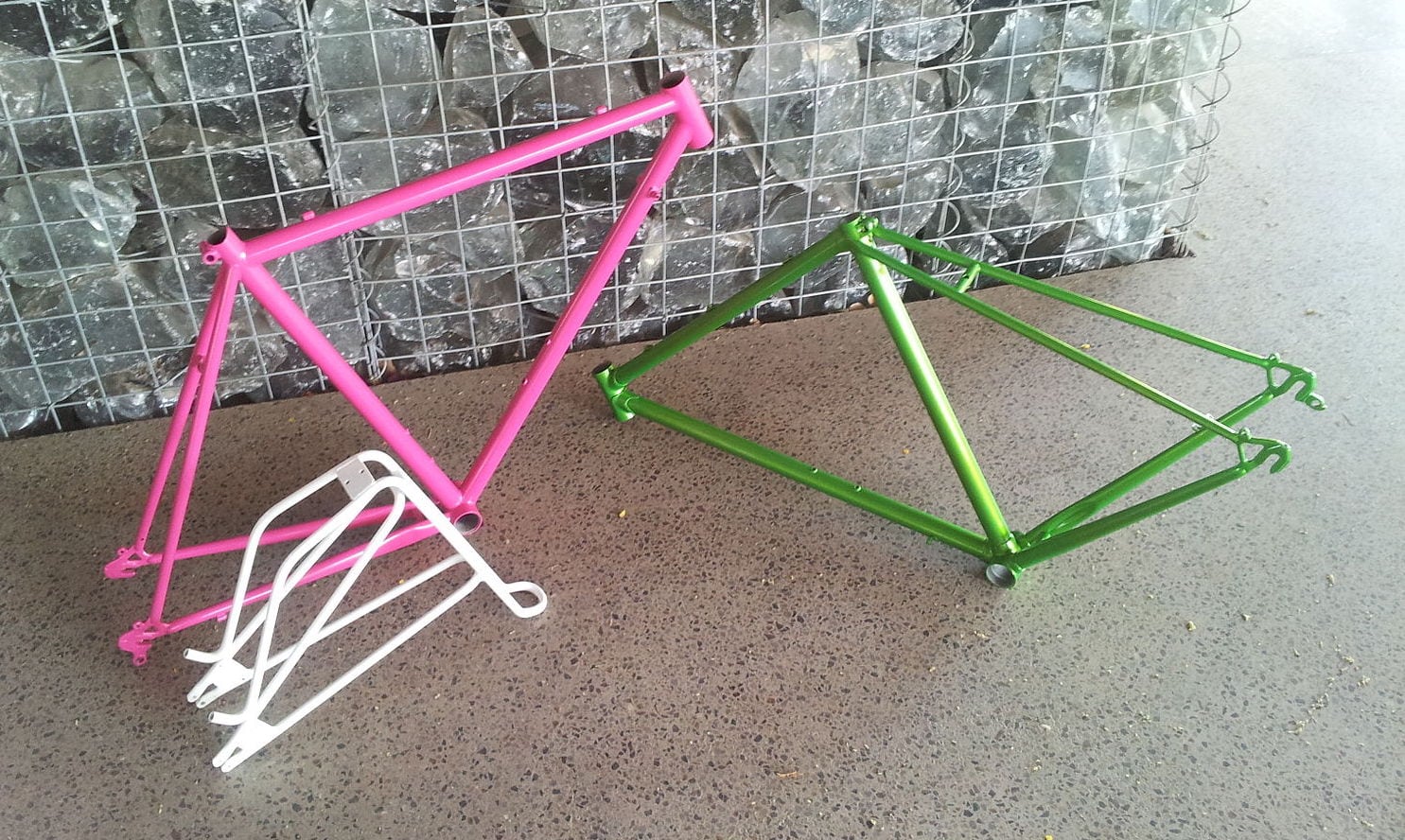
Powder-coated bicycle parts. Image by 802bikeguy, CC BY-SA 3.0, Wikimedia Commons, https://ow.ly/priH30lHzBv
Powder coating is a baked-on finish that is commonly applied to fittings, tools, and pipes. Powder-coated finishes also cover many refrigerators, automobiles, washing machines, air conditioners, televisions, and — increasingly — the components that go into these types of products, including the connectors. You likely have a powder-coated appliance in your home or drive a powder-coated automobile, but may not yet own a device that employs powder-coated connectors, as they’re a fairly recent development. One reason for the lag may be that the ability to powder coat electronic hardware depends heavily on the product size and configuration. Powder coating very small connectors and cables often remains an elusive task. The coating is more commonly used in heavy-duty connectors for rail and large vehicle applications.
The process is beginning to make in-roads in the electronic component industry, however. Powder coatings can provide enhanced consistency and improved performance for connectors and other components. The finish can range in texture from very smooth to pebbled, depending on a manufacturer’s needs and desires. Powder-coated parts can also withstand high temperatures and can bestow anti-microbial properties, allowing parts to be used in medical devices and food-handling equipment, according to powder manufacturer Wanshun Powder Coating.
Connector manufacturers that offer powder-coated products include TE Connectivity, Wieland, Molex, HARTING, and Panduit.
A Brief History of Powder Coating
Powder coating has been around since the early 1950s. Bosch developed a basic epoxy resin powder while searching for a new electric insulation material that could replace the materials then used to insulate metal dishwashing baskets, to protect metal furniture against rust and corrosion, and to protect boat accessories against mold, according to JC Metal Fabrication Inc., Reed City, Mich., which makes the booths in which the coating is sprayed onto a product.
Initially, however, the way the powder was applied resulted in film thicknesses that were much too high for many applications. Advances in application methods and improved powder formulations brought powder coating to wider popularity in the 1980s.
The main difference between a conventional liquid paint and a powder coating is that powder coatings don’t require a solvent to keep the binder and filler parts in a liquid suspension form. These coatings are generally applied electrostatically, with electrically charged powder pulled toward a conductive part by an electrostatic charge, said Duncan Alexander, who owns Spectrum Powder Manufacturing in Calgary, Canada.
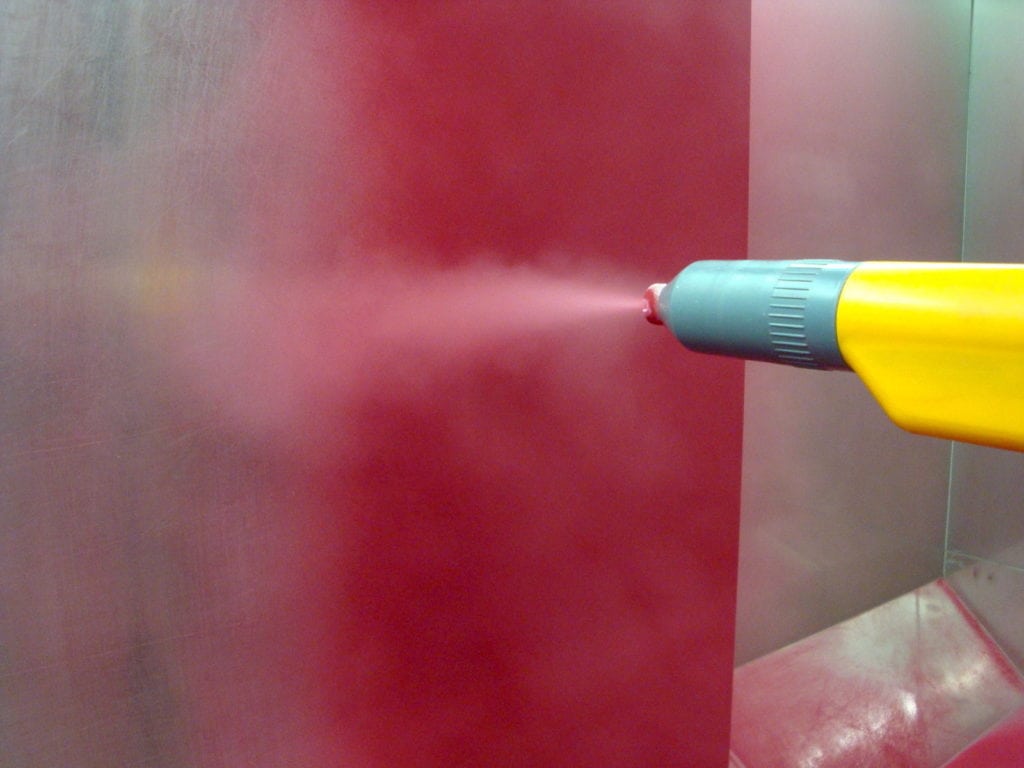
Dry powder is sprayed over a product’s surface using a specially developed spray gun within a dedicated booth that includes machinery dedicated to sucking excess powder from the booth for reuse, which saves on materials cost and cuts down on environmental contaminants. Alternatively, the parts can be lowered into a bed of fluidized powder.
Electronics generally use epoxy powder coatings that can produce protective surface thicknesses ranging from 6mm to 120mm (0.006” to 0.120”) and create a cross-link when cured, increasing the coating’s molecular weight and insulation capability. Other advantages of this type of powder is that it protects against corrosion and carries an insulation rating of 800V/mm at a minimum of 10mm. Epoxy powder is also chemically resistant and is one of the oldest powder paints used in the electronics industry, according to JC Metal Fabrication.
Whatever the technique used, the powder-coated part must be cured in an infrared oven. When done “baking” — usually in around 30 minutes — the finish is either smooth and hard across the product, like a car’s finish, or evenly textured and hard, like some countertops.
What About Connectors and Cabling?
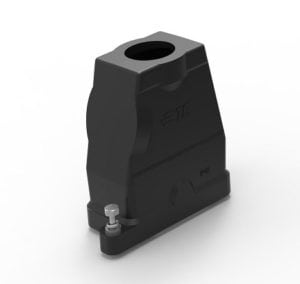
TE Connectivity’s HDC IP68 powder-coated anti-corrosion hoods and housing
Connector manufacturers are actively beginning to look into powder coating methods. Swagelok, a gas and fluid systems components company in Solon, Ohio, recently issued a design change notice regarding the coating for one of its tube cutters for stainless steel, soft copper, and aluminum tubing ranging from 0.1875” to 1”. In an effort to improve the product, these tube cutters will now be powder coated, delivering a textured finish, a more ergonomic feel, and improved grip. The company already offers other powder-coated components, including the lockout handle on its DP Series compact pneumatic and manual actuators.
TE Connectivity is using powder coating for electrical components that are exposed to harsh environments. Principal among these are rail, wind energy, and industrial transportation, such as train sub-systems and inter-vehicle connections, vehicle washing facilities, and electronic modules exposed to detergents, wind turbine brakes and pitch drives, and mining equipment.
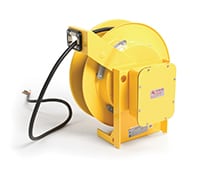
Molex Woodhead POW-R-MITE
The new hoods and housings have a robust design in a powder-coated die-cast aluminum alloy and are available in several different colors. They lock together with stainless steel M6 screws, and a nitrile rubber seal ensures protection against ingress of dust and liquids to a level of IP68.
Molex powder coats several of its offerings, including the Woodhead® POW-R-MITE® and POW-R-MATIC® industrial duty cable reels. Designed for demanding indoor and outdoor industrial applications, these spring-powered reels are made from precision electrical and mechanical components, accommodate up to 48.8mm of 16/3 AWG cable or up to 15.3mm of 6/3 AWG cable, and have a protective powder-coated exterior.
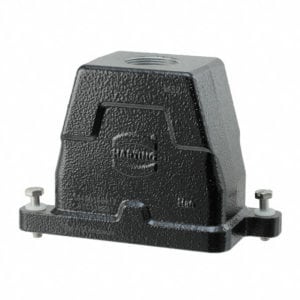
HARTING HAN HPR Series hood
HARTING offers powder-coated hoods, housings, and accessories in its Han® HPR Series, which uses Han-Modular® insert modules and frames to achieve a variety of insert configurations for signal, powder, and pneumatic lines within a single-connector assembly. Han HPR Series products are made from durable die-cast aluminum and are then protected with a black epoxy powder coating, which makes them suitable for use in harsh-environment railway and vehicle applications that require connectors with an IP68 rating when mated.
These and other companies are dipping a toe into the waters of powder coating. As they discover more about the process and bring more powder-coating booths and fluidized beds into their plants, expect to see the use of powder coating take off within the connector industry.
Interested in a specific market? Click a market below for current articles and news.
Automotive, Consumer, Industrial, Medical, Mil/Aero, Datacom/Telecom, and Transportation








